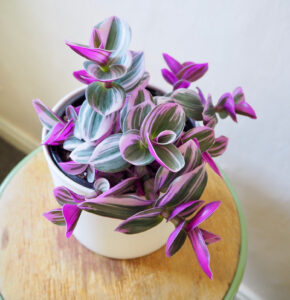Plum Crazy Oxalis (Oxalis triangularis), also known as Purple Shamrock or False Shamrock, is a stunning ornamental plant known for its deep purple, triangular leaves and delicate white or pale pink flowers. It’s a relatively easy plant to care for and can be grown both indoors and outdoors in the right climate. Here’s a care guide for your Plum Crazy Oxalis:
1. Light Requirements:
- Bright, indirect light is ideal for Plum Crazy Oxalis.
- While it can tolerate some direct sunlight, too much exposure may cause the purple color to fade.
- In low light conditions, the plant may become leggy and not bloom as much.
2. Watering:
- Keep the soil slightly moist, but do not let it stay soggy.
- Water when the top inch of soil feels dry to the touch.
- Ensure the pot has good drainage to avoid waterlogging the roots.
- During its dormant period (usually in the winter), reduce watering significantly. The plant may go through a natural rest phase, and it will not need as much water.
3. Humidity:
- Oxalis plants prefer moderate humidity.
- While they do fine in average household humidity, they will thrive with higher humidity, especially during the growing season.
- To increase humidity, you can mist the plant occasionally, use a humidity tray, or place a humidifier nearby.
4. Temperature:
- Ideal temperatures range between 60°F to 75°F (15°C to 24°C).
- It’s sensitive to cold temperatures, so avoid placing it in areas with drafts or temperatures below 50°F (10°C).
- During the winter months, it may go dormant, where its growth slows and the plant might appear to “die back.”
5. Soil:
- Use well-draining soil that retains some moisture but doesn’t become waterlogged.
- A standard houseplant potting mix works fine, but you can improve drainage by mixing in some perlite or sand.
- Make sure your pot has adequate drainage holes to prevent root rot.
6. Fertilizing:
- Fertilize with a balanced liquid fertilizer once a month during the growing season (spring and summer).
- Reduce or stop fertilizing in the fall and winter when the plant is dormant.
- Over-fertilizing can cause the plant to grow too quickly and lose its vibrant color, so always follow the recommended dosage.
7. Pruning:
- Prune away any yellowing or dead leaves to keep the plant looking neat.
- If the plant becomes leggy, you can trim back the stems to encourage a bushier appearance.
- Cutting back the plant at the end of its dormant period (if needed) can also help stimulate new growth in the spring.
8. Repotting:
- Repot your Plum Crazy Oxalis every 1-2 years or when it outgrows its pot.
- When repotting, choose a pot that is 1-2 inches larger in diameter than the current pot.
- Repot during its active growing season (spring or early summer) for the best results.
9. Pests and Diseases:
- Oxalis is generally pest-resistant, but it can occasionally be affected by aphids, mealybugs, or spider mites.
- If pests are noticed, treat the plant with insecticidal soap or neem oil.
- Ensure the plant has good airflow to help prevent fungal issues, such as powdery mildew.
10. Dormancy:
- Oxalis plants go through a dormant period where they may lose some or all of their leaves. This is a normal part of their growth cycle.
- During dormancy, reduce watering significantly, and the plant will rest and rejuvenate.
- In early spring, new shoots will start to appear, signaling the start of the growing season.
11. Growth and Size:
- Plum Crazy Oxalis typically grows to about 12-18 inches (30-45 cm) tall and wide, but its size can vary depending on growing conditions.
- The purple triangular leaves and delicate flowers make it a great ornamental plant for both indoors and outdoors (in zones 6-10).
12. Propagation:
- Bulb division is the most common method of propagation for Oxalis.
- During the dormant period, you can gently remove the bulbs from the soil and divide them.
- Replant each bulb in its own pot with fresh soil.
- You can also propagate through leaf cuttings, but this method can be more challenging.
13. Winter Care:
- If your Plum Crazy Oxalis is grown outdoors and you live in a region where it gets cold, you may need to bring the plant indoors during the winter.
- Indoors, it will go into dormancy, and you may notice the leaves die back. Just reduce watering, and the plant should bounce back in the spring.
Plum Crazy Oxalis is a gorgeous and relatively low-maintenance plant with its rich purple leaves and delicate blooms. It’s a great choice for adding a splash of color to your home or garden, and with the right care, it will reward you with vibrant foliage and charming flowers year after year.


